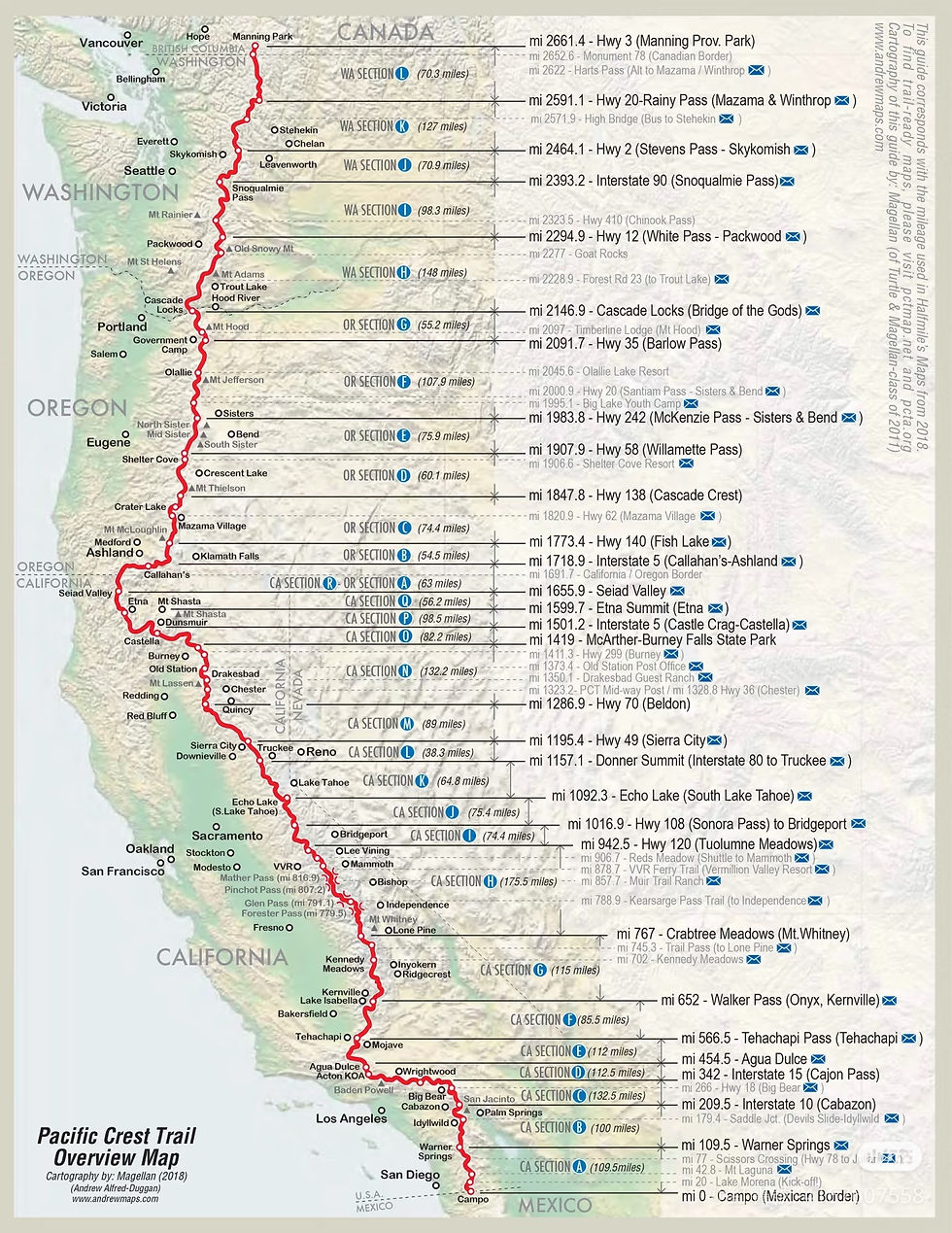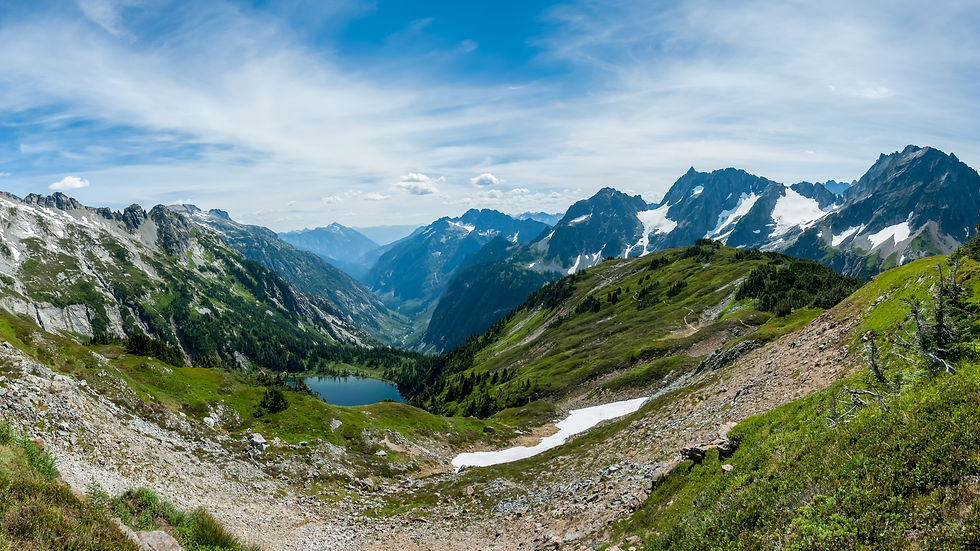The Pacific Crest Trail: A Legendary Journey Through America's Wild Heart
- OutdoorHongKong

- May 3
- 5 min read


The Pacific Crest Trail Introduction
The Pacific Crest Trail (PCT) is more than just a hiking route—it's a transformative journey that spans 2,650 miles across the western United States. Stretching from the sun-drenched border of Mexico to the snow-capped wilderness of Canada, this iconic trail traverses some of the most breathtaking and diverse landscapes in North America. From arid deserts and volcanic peaks to lush alpine meadows and ancient forests, the PCT offers an unparalleled experience for adventurers, nature lovers, and soul seekers alike.
In this comprehensive guide, we’ll delve deep into the Pacific Crest Trail’s history, geography, preparation tips, ecological significance, and more. Whether you're planning a thru-hike or simply curious about this legendary path, this article is your ultimate resource.
Table of Contents
History of the Pacific Crest Trail
Geography and Route Overview
Best Time to Hike the PCT
Essential Gear for the Trail
Training and Preparation
Permits and Regulations
Wildlife and Natural Wonders
Challenges and Dangers
Cultural and Spiritual Impact
Tips for Thru-Hikers
Pacific Crest Trail FAQs
Conclusion
History of the Pacific Crest Trail
The idea for the Pacific Crest Trail was born in the 1930s, inspired by the vision of Clinton C. Clarke, who proposed a continuous trail along the crest of the Sierra Nevada and Cascade mountain ranges. However, it wasn’t until 1968 that the trail was officially designated as a National Scenic Trail under the National Trails System Act.
The trail was completed in 1993, thanks to the efforts of thousands of volunteers and organizations like the Pacific Crest Trail Association (PCTA). Today, the PCT stands as a testament to American conservation efforts and outdoor passion.

Geography and Route Overview
The Pacific Crest Trail spans three states:
California – 1,691 miles
Oregon – 455 miles
Washington – 502 miles
Major Sections of the Trail
Southern California
Begins at the Mexican border near Campo
Features desert terrain, Joshua trees, and the San Jacinto Mountains
Central California (Sierra Nevada)
Home to Yosemite National Park, Kings Canyon, and Mount Whitney
High elevations and alpine lakes
Northern California
Includes Lassen Volcanic National Park and the Trinity Alps
Oregon
Volcanic landscapes, Crater Lake, and dense forests
Washington
Rugged terrain, North Cascades, and the final stretch to the Canadian border
Best Time to Hike the PCT
Timing is crucial for a successful hike. Most thru-hikers begin in April or May to avoid snow in the Sierra Nevada and reach Washington before early snowfall.
Seasonal Considerations
Spring (April–June): Ideal for starting in Southern California
Summer (July–August): Best for the Sierra and Oregon
Fall (September–October): Washington’s beauty peaks, but weather becomes unpredictable

Essential Gear for the Trail
Packing smartly is key to surviving and thriving on the PCT. Here’s a breakdown of must-have items:
Backpacking Essentials
Ultralight backpack (40–60L)
Tent or tarp shelter
Sleeping bag (rated for 20°F or lower)
Sleeping pad
Clothing
Moisture-wicking base layers
Insulated jacket
Rain gear
Wide-brimmed hat and sunglasses
Footwear
Trail runners (preferred over boots)
Gaiters
Extra socks
Navigation & Safety
GPS device or PCT maps
Compass
First aid kit
Bear canister (required in some areas)
Cooking & Hydration
Lightweight stove
Water filter or purifier
Collapsible water bottles
Training and Preparation
Hiking the PCT is a physical and mental challenge. Preparation is essential.
Physical Conditioning
Long-distance hikes with a loaded pack
Strength training (especially legs and core)
Cardiovascular endurance
Mental Preparation
Practice mindfulness and resilience
Familiarize yourself with solitude and discomfort
Read memoirs like “Wild” by Cheryl Strayed
Permits and Regulations
To protect the trail and its ecosystems, several permits are required.
Key Permits
PCT Long-Distance Permit (for 500+ miles): Apply here
California Fire Permit
Wilderness Permits (for national parks)
Leave No Trace Principles
Pack out all trash
Camp at least 200 feet from water sources
Respect wildlife and other hikers
Wildlife and Natural Wonders
The PCT is a living museum of biodiversity and geological marvels.
Notable Wildlife
Black bears
Mountain lions
Rattlesnakes
Marmots
Bald eagles
Natural Highlights
Challenges and Dangers
While rewarding, the PCT is not without risks.
Common Hazards
Dehydration and heatstroke
Hypothermia
River crossings
Snowfields and avalanches
Injuries from overuse or falls
Safety Tips
Always check trail conditions
Carry a personal locator beacon
Hike with a buddy when possible
Cultural and Spiritual Impact
The PCT has inspired countless books, films, and personal transformations. It’s not just a trail—it’s a pilgrimage.
Cultural Significance
Featured in “Wild” (film and book)
Celebrated in hiking communities
Annual trail days and festivals
Personal Growth
Builds resilience and independence
Encourages environmental stewardship
Fosters a deep connection with nature
Tips for Thru-Hikers
If you’re planning to hike the entire trail, consider these expert tips:
Start early to avoid the desert heat
Resupply smartly—use resupply points
Keep a journal or blog to document your journey
Practice ultralight backpacking techniques
Join online forums for advice and camaraderie
Pacific Crest Trail FAQs
1. How long does it take to hike the entire Pacific Crest Trail?
Most thru-hikers take between 4.5 to 6 months to complete the trail, depending on pace, weather, and rest days.
2. Do I need a permit to hike the PCT?
Yes, especially for long-distance hikes over 500 miles. You can apply for a PCT Long-Distance Permit.
3. What’s the best direction to hike the PCT?
Most hikers go northbound (NOBO) from Mexico to Canada due to snow conditions and logistics.
4. How do I resupply food and gear?
There are numerous resupply points along the trail, including post offices, towns, and hiker boxes.
5. Is it safe to hike the PCT alone?
Yes, but precautions should be taken. Many solo hikers complete the PCT each year. Always inform someone of your location and carry emergency communication devices.
Conclusion
The Pacific Crest Trail is more than a physical challenge—it’s a spiritual odyssey that connects hikers with the raw, untamed beauty of the American West. Whether you’re planning a thru-hike or dreaming of a section hike, the PCT offers an experience that will stay with you for a lifetime.
By preparing wisely, respecting the land, and embracing the journey, you’ll join a legacy of adventurers who have walked this path before you. The trail is waiting—are you ready to answer the call?
Related Resources
“In every walk with nature, one receives far more than he seeks.” – John Muir
If you found this guide helpful, share it with fellow adventurers and bookmark it for future reference. The trail may be long, but the journey begins with a single step.








Comments